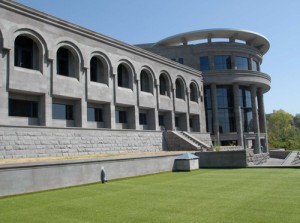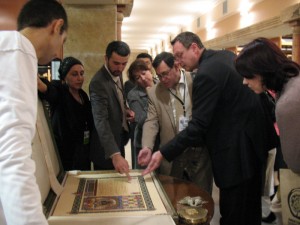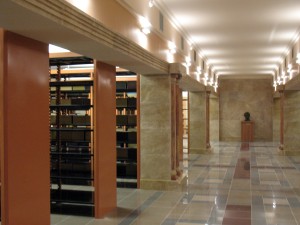Getting to know the Matenadaran Institute of Ancient Manuscripts after Mashtots
Armenians are a nation who is able to store and transfer from generation to generation its sacred respect to manuscript and sometimes books written in blood. It is an indicator of culture and verification of centuries long love to its own roots. (R.Gamzatov)
The word Matenadaran is translated from Armenian into English as a repository of ancient manuscripts.
Read also
The first repository of the written Armenian culture was founded in the 5th century. In 405 Mesrop Mashtots created the Armenian alphabet and with his own colleagues and laid the foundation of literature in his native language. “In those days in Vagharshapat –the capital of theArmenianKingdom under the Echmiadzin catholicos, there was a repository –Matenadaran where with foreign manuscripts started restoring the first Armenian manuscripts” tells Ara Khzmalyan, manager of archival department at the Matenadaran Institute of Ancient Manuscripts.
Modern institute called “Matenadaran after M. Mashtots” is located in the city ofYerevanin theRepublicofArmenia. This scientific research center is considered one of the biggest repositories of manuscripts in the world. The greatest collections of ancient Armenian manuscripts are kept here.
Nowadays Armenian transcripts are kept in the libraries and museums of many countries (inVenice, inParis, inLondon, inMoscow, inTbilisi,Viennaand others). The overall number of these manuscripts reaches 30 000.
“The number of manuscripts at the Matenadaran in comparison with the quantity of the manuscripts that are stored in Echmiadzin has increased almost four times. The total number of manuscripts by the first of January, 2010 was 17 260 from which 11 178 – integral ancient Armenian manuscripts, 497 – Armenian talismans, the 377-newest manuscripts and the 177-non published catalogs of manuscripts” said Ara Khzmalyan, manager of archival department at the Matenadaran Institute of Ancient Manuscripts.
Separate samples of the hand-written treasures are stored at the Matenadaran and exhibited in two halls.
“Manuscripts have different sizes and various executions. The biggest Armenian manuscriptMushsky Gomiliary – has the sizes 55,3 х 70,5 cm, its weight of 27,5 kg, and the smallest one is the Calendar of 1434 year, 3х4 cm, weight of 19kg. Mushsky Gomiliary is the collection of speeches and sermons, Armenians, martyrdoms, common Christians sacred and “fathers of church”. “It has been written in 1200-1202 years”, tells Ara Khzmalyan, manager of archival department at the Matenadaran Institute of Ancient Manuscripts.
According to Ara Khzmalyan, after the creation of letters inArmeniabig educational work started. The Bible, many antique works and early Christian authors’ work had been translated; original historical works and philosophical spiritual poetry had been created.
From ancient Armenian translations of Aristotle’s “Categories”(384-322 B.C.), and Dionysius the Thracian’s “Grammar Art” (170-90 B.C.) are presented at the exhibition hall.
Along with the hand-written books, the Matenadaran also possesses a collection of the medieval archival documents with more than 100 000 units as well as old Armenian printed books. Armenians are one of the first nations who printed their books in their native language.
All materials which are stored in Matenadaran are processed, investigated and offered to historians, philologists and other experts who study in various areas of a medieval science and culture.
The scientific – research work of the Institute has become more purposeful and systematic after the foundation of the Institute in 1959. The studying of manuscripts is concentrated in the sectors of scientific bibliography, researches and publications of the written pieces of the V-XII centuries, study of texts and archival documents of the XIII-XVIII centuries, scientific transfer, and art study; there is also a sector of scientific storage and restoration of manuscripts.
The construction of the Matenadaran’s building was finished in 1957, and in 1959 the Matenadaran moved to a new building with its rich collections. The same year under the decision of the Government the Matenadaran was given a status of the Scientific Research Institute of Ancient Manuscripts; and since 1962 has carried the name of the creator of the Armenian letters Mesrop Mashtots.
For the moment, more than 200 people work at the institute. Matenadaran actively cooperates and implements its projects with various research centers in the world.
Recently, from 24 to 28 of October, 2011, The Institute of Ancient Manuscripts Mesrop Mashtots with the support of Ministry of Culture of Republicof Armeniaand International Humanitarian Cooperation Fund of the CIS states held a seminar called “Memory Faces”. The newest technologies of preservation and rebuilding of manuscripts and printing heritage», devoted to the 500th anniversary of book publishing inArmenia in order to unite professional efforts in the field of preservation and restoration of a hand-written and printing heritage of Commonwealth of Independent States member countries.
“The quantity of students applying to our institute increases every year. We have all opportunities for our students to develop their potentials. We support our students because it is vey important for us to prepare young professional so that our institute further could develop and preserve its traditions. We organize various seminars and trainings in order to unite professionals in the field of preservation and restoration of a hand-written and printing heritage”, said Ara Khzmalyan.
By the way along with thousand Armenian manuscripts more than two thousand manuscripts in Russian, Persian, Latin, Japanese, Arabian, Greek, Hebrew, Syrian, Turkic (including Kyrgyz) and other languages are stored here.
Matenadaran holds research work on learning and the publication of monuments of Armenian hand – writing, on problems of textual criticism, a source study, paleography, medieval book painting, a historiography, realizes and conducts scientific translation of hand written manuscripts into Russian and other languages.
Talgat Akishov,Yerevan




























































